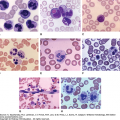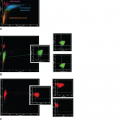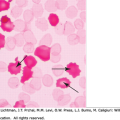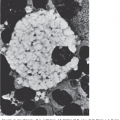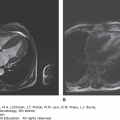INTRODUCTION
SUMMARY
Anemia is the most common hematopoietic abnormality in endocrine disorders and may be the first manifestation of an endocrine disorder. Polycythemia/erythrocytosis is less common, but occurs in certain endocrine disorders. The pathophysiologic basis of the anemia is often multifactorial, but a direct influence of hormones on erythropoiesis in some instances may contribute to anemia. A decreased plasma volume in some of these disorders may mask the severity of anemia. It has been proposed that anemia in endocrine-deficiency states may be physiologic to adjust for decreased oxygen requirements. Some endocrine disorders are associated with an impaired response to the therapeutic use of erythropoietin.
THYROID DYSFUNCTION
Anemia is a well-recognized complication of thyroidectomy and other causes of hypothyroidism and may also occur in subclinical hypothyroidism.1 In a retrospective review, anemia defined as a hemoglobin less than 13 g/dL in men and less than 12 g/dL in women was present in 57 percent of patients with hypothyroidism.2 The anemia in hypothyroidism has been described variably as normocytic, macrocytic, or microcytic3 coexisting deficiencies of iron, vitamin B12, and folate may explain some of this heterogeneity. In a study of approximately 60 anemic patients with untreated primary hypothyroidism, 10 percent had a macrocytic anemia, all of whom had vitamin B12 deficiency, 43 percent had a microcytic anemia and iron deficiency, and the remainder had a normocytic anemia.4 However, even when these deficiencies have been excluded, some hypothyroid patients have a macrocytic anemia.5 In addition, although most hypothyroid patients have a significant reduction in their red cell mass, anemia is not always evident from hemoglobin and hematocrit values owing to a concomitant reduction of plasma volume.6,7
Hypothyroidism may contribute to the development of iron deficiency (Chap. 43) due to associated menorrhagia, although this association is less common than previously thought.8 Because thyroid hormone may augment iron absorption,9,10 iron deficiency in hypothyroidism may also be caused by impaired iron absorption, either directly from a lack of thyroid hormone or an associated achlorhydria.11,12 Conversely, iron deficiency impairs thyroid hormone synthesis by reducing the activity of heme-dependent thyroid peroxidase.13 In patients with coexisting iron-deficiency anemia and subclinical hypothyroidism, the anemia often does not adequately respond to oral iron therapy. Combined treatment with oral iron and levothyroxine results in superior improvement in hemoglobin and ferritin levels compared with levothyroxine alone in these patients.14,15
Although the macrocytosis seen in hypothyroid patients may be due to deficiencies of vitamin B124,5 or folate16 (Chap. 41), hypothyroidism also causes macrocytosis that resolves with thyroxine treatment.5 The mean corpuscular volume of hypothyroid patients with low vitamin B12 levels is similar to those with uncomplicated hypothyroidism, so this is not a sensitive means of identifying patients with hypothyroidism complicated by B12 deficiency.5 Although there is an established association of hypothyroidism and pernicious anemia,17,18 the underlying mechanism is unclear. In one analysis of 116 hypothyroid patients, 40 percent had low serum vitamin B12 levels.19 Although the mean hemoglobin was slightly lower in the vitamin B12–deficient group (11.9 g/L vs. 12.4 g/L), the mean corpuscular volume and prevalence of antithyroid antibodies did not differ between the two groups.19
However, even when iron deficiency, vitamin B12 deficiency, and other confounding causes of anemia have been excluded, anemia can be a direct consequence of thyroid hormone deficiency.5,16 Dogs subjected to thyroidectomy have a normocytic, normochromic anemia that is associated with reticulocytopenia and marrow erythroid hypoplasia.20 In hypothyroid humans and thyroidectomized animals, the red cell life span is normal, and results of ferrokinetic studies are compatible with hypoproliferative erythropoiesis.20,21 Administration of thyroid hormones increases the rate of red cell production in experimental animals,22 whereas thyroidectomy decreases red cell production.23 Because thyroid hormones affect the cellular needs for oxygen, these responses are compatible with an appropriate physiologic adjustment. Evidence of a direct effect of thyroid hormones on erythropoiesis exists. Some in vitro studies show that triiodothyronine, thyroxine, and noncalorigenic resin triiodothyronine all potentiate the effect of erythropoietin on erythroid colony formation.24 Thyroid hormones also increase hypoxia-induced production of erythropoietin in the rat kidney and a human hepatoma cell line.25 However, other in vitro studies show an inhibitory effect of triiodothyronine on erythroid colony formation, particularly in combination with all-trans retinoic acid.26
Hypothyroidism may also affect the response to erythropoietin therapy. After adjusting for other variables, the mean monthly erythropoietin dose required to maintain a target hemoglobin level in hemodialysis patients was significantly higher in hypothyroid compared with euthyroid patients.27
Improvement in the hemoglobin concentration in response to thyroid hormone therapy is seen over a several-month period.5 White blood cell and platelet counts usually are unaffected in hypothyroidism. However, pancytopenia in association with marrow hypoplasia has been reported in a patient with myxedema coma; the hematologic abnormalities in this patient resolved with thyroid hormone replacement.28
Although thyroid hormone administration increases red cell production in animals,29 humans with hyperthyroidism generally do not have erythrocytosis. Anemia is present in 10 to 25 percent of these patients.30,31,32 This finding may be the result of increased plasma volume7; however, decreased red cell survival33 and ineffective erythropoiesis34 also have been described. Antithyroid treatment ameliorates the anemia.31,32 A patient with autoimmune hemolytic anemia and hyperthyroidism has been described; the hemolysis in this patient abated with treatment of the hyperthyroidism.35 Pancytopenia rarely occurs but also may respond to treatment of hyperthyroidism.36,37
ADRENAL GLAND DISORDERS
A normocytic normochromic anemia may be seen in primary adrenal insufficiency (Addison disease),12,38 but the anemia may also be masked by the concomitant reduction in plasma volume that is common in this disease.38 In a series of patients with Addison disease, some patients with normal hemoglobin levels developed transient anemia after initiation of hormone replacement therapy, presumably secondary to an increased plasma volume.38
In experimental animals, adrenalectomy causes a mild anemia that responds to glucocorticoids.39 However, the pathophysiologic basis of the anemia and any influence of adrenal cortical hormones on erythropoiesis are not well defined.
Pernicious anemia occurs in patients with autoimmune adrenal insufficiency, but is seen primarily in patients with type I polyglandular autoimmune syndrome, whose other manifestations include mucocutaneous candidiasis and hypoparathyroidism.40 Anemia as a result of primary erythropoietin deficiency was reported in one patient with this syndrome.41
Glucocorticoids interact with erythropoietin in vitro to enhance erythroid colony proliferation.42 Glucocorticoid receptors, activated by their cognate ligand, initiate Janus kinase 2 phosphorylation-mediated cytoplasmic signal transduction, which may stimulate erythropoiesis by a mechanism shared with erythropoietin (Chaps. 32 and 57). Erythrocytosis has been reported in Cushing syndrome,43 primary aldosteronism,44 and Bartter syndrome.45
However, a study of 63 women and 17 men with Cushing disease found that although the hemoglobin levels in the females were evenly distributed over the normal range, the hemoglobin levels were in the lowest quartile in 14 of the 17 men, and 3 of these 14 were anemic.46 The reduced hemoglobin levels in the male patients correlated with a low testosterone level and slowly improved after treatment of Cushing disease.
The most common cause of congenital adrenal hyperplasia is 21-hydroxylase deficiency, which impairs conversion of 17-hydroxyprogesterone to 11-deoxycortisol.47 Patients with the “classic form” present during the neonatal period with adrenal insufficiency, but others have a late onset presentation with findings of androgen excess. Erythrocytosis, likely a consequence of increased androgen levels, has been reported in patients with congenital adrenal hyperplasia resulting from 21-hydroxylase deficiency,48 and erythrocytosis has also been described as the presenting manifestation of this disease.49
Pheochromocytomas and the closely related tumor, paraganglioma, are rarely associated with erythrocytosis. This finding is believed to be a result of autonomous erythropoietin production by the tumor,50 often mediated by von Hippel-Lindau mutations that cause or contribute to pheochromocytoma development (Chaps. 32 and 57).
However, several individuals with congenital polycythemia have developed recurrent pheochromocytomas, paragangliomas, and sometimes somatostatinomas.51,52 Their tumors are heterozygous for a heterogeneous gain-of-function mutation of hypoxia-inducible factor-2α gene and erythropoietin transcript is present in tumor tissues (Chaps. 32 and 57). However, these mutations are generally not found in nontumor tissues, so the etiology of the association of these tumors with polycythemia is unknown.51,52
A syndrome of congenital polycythemia associated with a mutation in the proline hydroxylase type 2 gene and recurrent paragangliomas has also been described in a single family.53
GONADAL HORMONES
Sexually mature males have higher hemoglobin levels than prepubertal males, older males, and females.54
Stay updated, free articles. Join our Telegram channel

Full access? Get Clinical Tree



